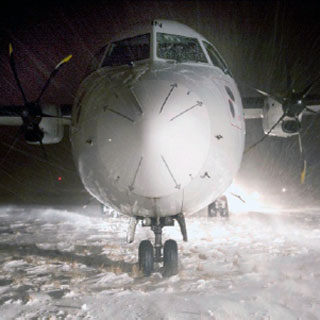
Cimber Air – ATR – ATR72-212A (OY-CIN) flight QI332
Timber Air flight QI332 incident ccurred during a scheduled flight from EKCH to Bornholm Airport (EKRN). The commander was Pilot Flying (PF) and the first officer was Pilot Non Flying (PNF). At 17:06:51 the pilots made radio contact with the control tower at EKRN.
The pilots got clearance to make a VOR/DME approach to runway 29 when passing 20 nm from ROE VOR (112,000 MHz).
The pilots were informed that the landing threshold to runway 29 was displaced. At the time, the available landing distance (LDA) was 1590 metres.
The ILS for runway 11 and runway 29 and the Precision Approach Path Indicator (PAPI) were not available.
Weather and runway conditions were reported as being: Wind conditions were 200 31 knots maximum 41 knots.Visibility was 300 metres in drifting snow. Runway visual range (RVR) was 800 metres, the clouds (broken) were at 700 and 1000 feet.Temperature and dewpoint were 5C. QNH was 1010 HPa. Transition Level (TL) was FL 55.
During landing roll of Cimber Air flight QI332 , the external visual references were limited because it was dark and snow drifting
At approximately 17:02, the braking action coeficients on runway 29 were measured to be 48, 51 and 53. 50% of runway 29 was covered in 2 mm dry snow. At 17:09:23, the control tower informed the pilots that the approach lights (high intensity) would be switched on for the landing but that no lights would be switched on between the original landing threshold and the displaced threshold for runway 29.
Immediately thereafter the pilots reported that due to the current RVR value of 800 metres they would fly to Fauna holding pattern (334 KHz) in order to wait for a better RVR value. Later (at 17:19:10) the pilots reported that a RVR value of 1000 metres was necessary in order for them to commence a VOR/DME approach to runway 29.
After being informed that wind conditions at 17:48:10 and at 17:55:53 (210 were 29 knots maximum 40 knots / 200 29 knots maximum 37 knots), at 17:58:25, the pilots decided to attempt a new VOR/DME approach to runway 29. The final approach speed determined by the pilots (correction for icing and wind conditions) was 120 knots IAS, and the flaps of the aircraft were extended to flap position 30. When passing radio altitude (RA) of 1000 feet, the aircraft was fully stabilized (stabilized approach).
During the landing roll the pilots noticed that the aircraft was beginning to veer to the left. PF corrected this so that the aircraft was guided back to the centre line of the runway. Unexpectedly, the pilots once again noticed that the aircraft was veering to the left. PF made maximum use of the wheel brakes and full reversing of both engines. The aircraft continued to veer over towards the left side of the runway. The pilots noticed that the nosewheel steering was not having any effect. The aircraft ran over the side of the runway and came to a complete stop in the safety zone. The pilots observed that there was no visible or noticeable damage and reported to the control tower that the aircraft had run over the side of the runway and had remained in the safety zone.
The speed during the landing roll was decreasing gradually leading to a decrease of rudder effectiveness, which, in marginal crosswind conditions, made it all the more difficult for the pilots to re-establish directional control. As a result of the marginal crosswind conditions, during the last part of the landing roll, it is likely that the aircraft was exposed to the weathercock effect, which intensified the aircraft’s trajectory over the side of the landing runway.
The contamination of the landing runway during the aircraft’s landing roll could have had a bearing on the effectiveness of the aircraft’s wheel brakes and nose wheel steering. Landing under marginal crosswind conditions in combination with possible runway contamination resulted in the aircraft running off the side of the runway (runway excursion).
Download Report

0 Comments